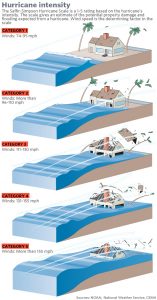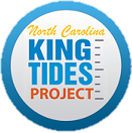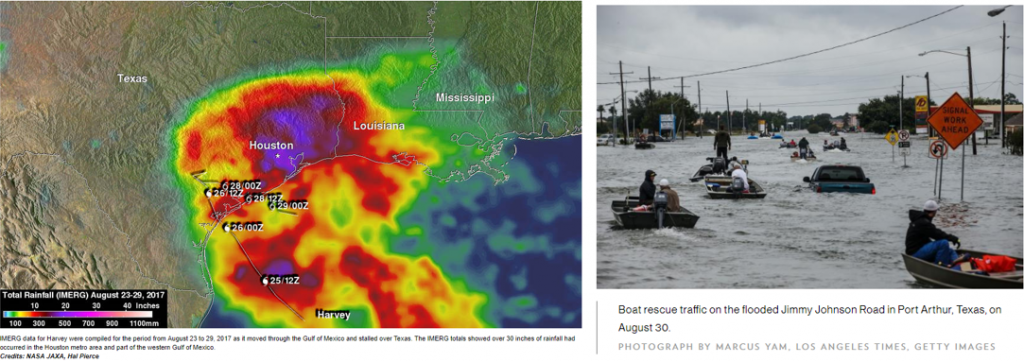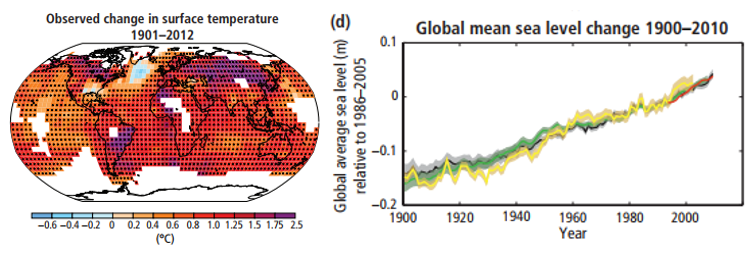Hurricane season has already seen landfall of two major hurricanes in the U.S., with another gaining strength in the Atlantic. Here we take a closer look at Harvey and Irma, and look at the future of hurricanes with respect to a changing climate.
Hurricane Harvey
Harvey, the first major storm of the year to make landfall in the U.S. has devastated much of the Gulf Coast with torrential downpours. The hurricane made landfall near Rockport, TX as a category 4 hurricane, with sustained 130 mph winds, as Harvey weakened it stalled out just inland of the Texas Gulf Coast. Once stalled, Harvey dropped tremendous amounts of rain, with the town of Cedar Bayou, just outside of Houston, receiving a record rainfall of 51.88 inches.1 This broke the previous tropical cyclone rain record of 48 inches set by Amelia in 1978 at Medina, Texas.2
Harvey’s record rainfall is somewhat surprising for a hurricane of its size. Generally, the more powerful a hurricane is the less likely it will stall out over land. This is due to the height of the cloud structure being easily effected by the influence of planetary wind patterns, leading it to be steered quickly to a new location.3
The record rainfall has led to catastrophic flooding throughout the Houston area. Overall, Harvey has dropped 33 trillion gallons of rain along the Gulf of Mexico, with 1 trillion gallons falling just over Harris County (home to Houston).4 To put that in perspective, there are only 18 trillion gallons of water in the Chesapeake Bay.4
Hurricane Irma
Hurricane Irma is the strongest hurricane on record to form in the Atlantic. This category 5 hurricane, holds the longest sustained energy for any cyclone around the globe, with sustained winds of 185 mph for 37 hours.5 It maintained its Category 5 status for 3 consecutive days, the longest for any Atlantic hurricane in the satellite era (since 1966).6 This is also the first time the U.S. has been hit by two Category 4 (or higher) storms in the same year.7
Irma has left extensive damage throughout the Caribbean and U.S. The storms intense winds have torn apart houses, lefts millions without power, and caused intense flooding, leaving entire islands decimated. So far, the death toll has reached 55 people, 11 in the U.S. and 35 in the Caribbean.8
Irma had its own mixture of unique circumstances. One of which was the unique phenomena of the storm actually pushing water away from the coast leaving much of Florida’s Gulf Coast with bare shorelines, despite warnings of extreme storm surge. This is because the storm hit slightly more inland, and at just the right time. Since Irma arrived from the south and was rotating in a counter-clockwise direction, it’s northwest side actually blew water away from the coast, draining areas as much as six feet.
While this phenomena reduced flooding in some areas, other parts of the U.S. were not as lucky. Tybee Island, GA, was cut off from Savannah with a storm surge of almost 5 feet that coincided with an exceptionally high tide, leading to swells of up to 15 feet.8 While, Jacksonville, FL saw record flooding, with water levels 4 to 6 feet above normal high tide levels.
The Future of Hurricanes
Satellite data of hurricanes has only been collected for the past 50 years or so, leaving estimates on changes in hurricane intensity and frequency uncertain. Therefore, it is difficult to determine what, if any, changes are due to human activity.
We do know that sea surface temperatures and sea levels have been rising steadily for the past 40 and 100 years, respectively (SST have likely also been rising since 1895 but data is limited).9 Hurricanes gain their strength from warm ocean temperatures, and higher water levels can increase flood risks. But what does this really mean for the future of hurricanes?
One of the concerns with increasing SST is that hurricanes could become more intense. Research suggests that there is an increase in the number of Category 4 and 5 hurricanes by a rate of 25-30% per ⁰C of warming since 1975 10. Following this initial increase, however, the shift towards more intense hurricanes may not continue at the same rate. One consideration is there will be a saturation levels, of 40-50% of category 4-5 occurrences, after which, further ocean warming may have little effect.10

Another concern is that if climate change causes higher SST then evaporation will occur at a greater rate leading to greater precipitation in hurricanes.11 Some models show precipitation increasing by 10-30% on average.12 , 13, 14 This suggests that events like the record rainfall from Harvey might occur more frequently.
Even if storm intensity does not increase, damage from storms due to sea level rise will increase due to more frequent and intense coastal flooding. Rising sea levels give storms surges a higher “launch point”, and estimates put coastal flood frequency doubling by 2080 (using low estimates).15 The increase in storm surge that may occur due to potential increases in hurricane intensity is only 10% of the increase in surge height that may result from sea level rise alone.16
Only 24% of landfalling tropical cyclones in the U.S. are category 3-5 hurricanes; however, these account for roughly 85% of hurricane related damage. Current estimates put the property damage costs at $150 to $200 billion dollars, with the possibility of another $20 to $30 billion in lost economic output. 17, 18 Broken up between the two storms, Harvey is estimated to cost $86 to $108 billion, while Irma’s estimates range from $62 to $92 billion.17 Costs associated with hurricanes are expected to rise. These additional costs are attributed to both the expected increase in population at the coast and the potential increase in storm intensity. If the costs of these two are separated out, at least $47 billion in additional damages are expected from climate change effects alone.19
How hurricanes will actually react to changes in our climate is still up for debate, however, there is already evidence to suggest storms will become more destructive in the future. This is all the more reason to be prepared and start planning for these possibilities.
What can you do?
Promote healthy marshes: marshes help protect our shorelines by providing a buffer from wave energy and acting as a sponge for extra water.
Take note of areas prone to flooding: submit your photos to NC King Tides so we can track which areas are getting flooded and what’s affected.
Talk to your local representatives: ask for a reduction in the use of impervious surfaces, keep track of zoning laws and regulations.
References
1 NOAA NCEP. The Weather Prediction Center. http://www.wpc.ncep.noaa.gov/discussions/nfdscc1.html Last updated: Aug 30 2017.
2 NASA. Harvey (was TD 09 – Atlantic Ocean). https://www.nasa.gov/feature/goddard/2017/harvey-atlantic-ocean Last updated: Sept 13 2017.
3 Willie Drye. National Geographic. Harvey May Become the Rainiest Storm in U.S. History – Here’s Why. http://news.nationalgeographic.com/2017/08/hurricane-harvey-floods-historic-rainfall/ Published: Aug 27 2017.
4 Angela Fritz and Jason Samenow. The Washington Post. Harvey unloaded 33 trillion gallons of water in the U.S. https://www.washingtonpost.com/news/capital-weather-gang/wp/2017/08/30/harvey-has-unloaded-24-5-trillion-gallons-of-water-on-texas-and-louisiana/?utm_term=.f56342171033 Published: Sept 2 2017.
5 NOAA National Hurricane Center. Hurricane Irma Intermediate Advisory Number 30A. http://www.nhc.noaa.gov/archive/2017/al11/al112017.public_a.030.shtml Last Updated: Sept 6 2017.
6 Colorado State. Hurricane Irma Meteorological Records/Notable Facts Recap. https://webcms.colostate.edu/tropical/media/sites/111/2017/09/Hurricane-Irma-Records.pdf Accessed: Sept 20 2017.
7 Alix Martichoux. SF Gate. NASA Video shows 10 days of Hurricane Irma in 30 Seconds. http://www.sfgate.com/news/article/NASA-video-Hurricane-Irma-satellite-movement-12187277.php Last Updated: Sept 11 2017.
8 Bill Chappell and Scott Neuman. NPR. Irma Recovery Begins; Storm Flooded Parts of Florida, South Carolina and Georgia. http://www.npr.org/sections/thetwo-way/2017/09/12/550386157/irma-recovery-begins-storm-flooded-parts-of-florida-south-carolina-and-georgia Published: Sept 12 2017.
9 Rhein, M., S.R. Rintoul, S. Aoki, E. Campos, D. Chambers, R.A. Feely, S. Gulev, G.C. Johnson, S.A. Josey, A. Kostianoy, C. Mauritzen, D. Roemmich, L.D. Talley and F. Wang, 2013: Observations: Ocean. In: Climate Change 2013: The Physical Science Basis. Contribution of Working Group I to the Fifth Assessment Report of the Intergovernmental Panel on Climate Change [Stocker, T.F., D. Qin, G.-K. Plattner, M. Tignor, S.K. Allen, J. Boschung, A. Nauels, Y. Xia, V. Bex and P.M. Midgley (eds.)]. Cambridge University Press, Cambridge, United Kingdom and New York, NY, USA.
10 Holland, G. & Bruyère, C.L. 2014. Recent intense hurricane response to global climate change. Clim Dyn 42(3-4): 617-627.
11 Sobel, A. H., Camargo, S. J., Hall, T. M., Lee, C., Tippett, M. K., Wing, A. A. 2016. Human influence on tropical cyclone intensity. Science 353 (6296): 242-246.
12 Walsh, K., and. Coauthors, 2015: Hurricanes and climate: The U.S. CLIVAR Working Group on Hurricanes. Bull. Amer. Meteor. Soc. 96: 997–1017.
13 Knutson, Thomas R. et al. 2010. Tropical Cyclones and Climate Change. Nature Geosci 3.3: 157-163.
14 Wuebbles, D. J., Kunkel, K., Wehner M., and Zobel. Z. 2014. Severe weather in United States under a changing climate. EOS 95(18): 149-156.
15 Horton, R., Little, C., Gornitz, V., Bader, D., and Oppenheimer, M. 2015. New York City panel on climate change 2015 report chapter 2: Sea level rise and coastal storms. Annals of the NY Academy of Sciences 1336(1): 36-44.
16 Balaguru, K., Judi, D. R., and Leung, L. R. 2016. Future hurricane storm surge risk for the U.S. gulf and Florida coasts based on projections of thermodynamic potential intensity. Climate Change 138(1-2): 99-110.
17 Steve Liesman. CNBC. Harvey and Irma economic hit could total $200 billion: Moody’s. https://www.cnbc.com/2017/09/11/harvey-and-irma-economic-hit-could-total-200-billion-moodys.html Published: Sept 11 2017.
18 Beth Corsentino. CNBC. Hurricanes Irma and Harvey may be a ‘wake-up call’ for vulnerable cities, and local zoning laws: Expert. https://www.cnbc.com/2017/09/11/harvey-and-irma-economic-hit-could-total-200-billion-moodys.html Published: Sept 17 2017.
19 Dinan, T. 2017. Projected increases in hurricane damage in the United States: the role of climate change and coastal development. Ecological Economics 138: 186-198.







One Response to “Hurricanes: Present and Future (September 21, 2017)”
Campervan Rental Australia
There’s certainly a lot to find out about this subject. I love all the points
you’ve made.